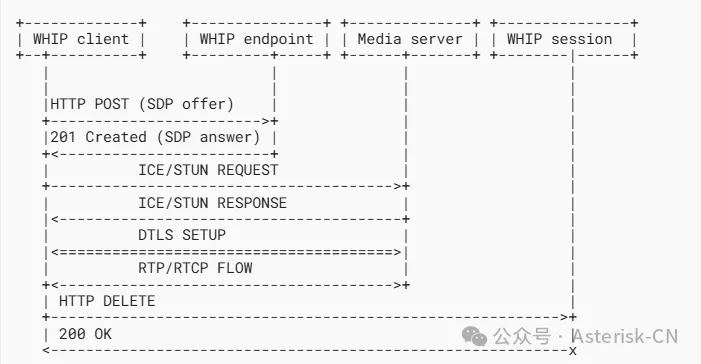The WebRTC HTTP Ingestion Protocol (WHIP) has officially become an RFC standard! This marks an important milestone based on WebRTC broadcasting technology.

The WebRTC-HTTP Ingestion Protocol (WHIP) is the latest formal specification regarding WebRTC, which means that the HTTP protocol related to WebRTC has finally become a standard. Below is a summary of the core sections of RFC 9725 (“WebRTC Ingestion Using an HTTP-based Protocol”), along with an analysis of its use cases and open-source project implementations.
Core Sections Summary and Analysis of RFC 9725
RFC 9725 defines a simple HTTP-based protocol for ingesting WebRTC content into streaming services or content delivery networks (CDNs). This protocol aims to address the integration issues between WebRTC real-time communication and traditional streaming infrastructure. Below is a summary of the core sections of the document, along with an in-depth interpretation based on practical use cases and open-source implementations.

Core Sections Summary
1. Introduction (Section 1: Introduction)
- • Core Content: RFC 9725 proposes an HTTP-based protocol designed to efficiently ingest real-time audio and video streams from WebRTC into streaming services or CDNs. It addresses the compatibility issues between native WebRTC protocols (such as RTP/RTCP) and traditional streaming (such as HLS/DASH).
- • Key Points:
- • WebRTC is typically used for peer-to-peer communication but lacks the capability for direct integration into large-scale distribution systems.
- • The protocol transmits media streams via HTTP POST requests, providing a lightweight and easy-to-deploy solution.
- • Expert Interpretation: This section lays the groundwork for the protocol’s motivation, emphasizing the balance between real-time performance and distribution efficiency, suitable for modern streaming architectures that require low latency and scalability.
2. Protocol Overview (Section 3: Protocol Overview)
- • Core Content: Defines the HTTP-based ingestion process, including how clients send WebRTC media streams to servers via POST requests and how servers handle this data.
- • Key Points:
- • Utilizes HTTP/1.1 or HTTP/2, supporting standardized media containers (such as WebM or MP4).
- • Introduces “Chunked Transfer Encoding” for real-time stream transmission.
- • The server confirms receipt through response codes (such as 202 Accepted).
- • Expert Interpretation: This design leverages the widespread support of HTTP, avoiding dependencies on complex protocol stacks while maintaining low latency characteristics. Chunked transfer is a key technology for achieving real-time performance.
3. Media Format and Encapsulation (Section 4: Media Format and Encapsulation)
- • Core Content: Specifies supported media formats (such as Opus audio, VP8/VP9 video) and encapsulation formats (such as WebM).
- • Key Points:
- • Requires clients to repackage WebRTC’s RTP streams into WebM or similar containers.
- • Supports timestamps and metadata to ensure synchronization and integrity of the streaming service.
- • Expert Interpretation: This section clarifies the technical implementation foundation, ensuring compatibility with the WebRTC ecosystem while providing flexibility for downstream distribution (such as transcoding to HLS).
4. Operational Procedures (Section 5: Operational Procedures)
- • Core Content: Describes the interaction process between clients and servers, including connection establishment, data transmission, and error handling.
- • Key Points:
- • Clients initiate HTTP POST requests carrying media streams.
- • Servers must support long connections and error retry mechanisms.
- • Defines timeout and reconnection strategies.
- • Expert Interpretation: The design of the operational process considers robustness and fault tolerance, suitable for stable operation in high-concurrency scenarios.
5. Security Considerations (Section 7: Security Considerations)
- • Core Content: Emphasizes the security requirements of the protocol, including authentication, encryption, and data integrity.
- • Key Points:
- • Recommends using HTTPS (TLS) to protect transmissions.
- • Suggests token-based authentication (such as OAuth).
- • Expert Interpretation: Security is a core requirement for real-time streaming applications, and this section provides clear guidance for production environment deployment.
Use Cases
Use Case 1: Real-time Live Streaming Platform
- • Requirement: Streamers push real-time audio and video from browsers to servers via WebRTC, which then distributes it to viewers.
- • RFC 9725 Application: The streamer client sends the WebRTC stream (packaged as WebM) to the ingestion server via HTTP POST, which then transcodes it to HLS/DASH for distribution to the CDN.
- • Value: Simplifies the ingestion process, reduces latency, and leverages existing HTTP infrastructure.
Use Case 2: Video Conference Recording
- • Requirement: Record and store audio and video streams from multi-party WebRTC video conferences in the cloud.
- • RFC 9725 Application: The conference server pushes each participant’s WebRTC stream to the storage service via HTTP, packaging it as MP4 files.
- • Value: Provides a standardized recording method, facilitating post-processing and playback.
Use Case 3: IoT Device Monitoring
- • Requirement: IoT cameras transmit real-time monitoring footage to cloud analysis systems via WebRTC.
- • RFC 9725 Application: Cameras push video streams to the analysis server via HTTP POST, supporting real-time processing and alerts.
- • Value: Utilizes the universality of HTTP, reducing the protocol implementation complexity for IoT devices.
Open Source Project Implementations
Below are some open-source projects related to RFC 9725 and how they implement protocol functionalities:
1. GStreamer
- • Functionality Implementation: GStreamer is a multimedia framework that supports the conversion from WebRTC to WebM and can implement the ingestion process of RFC 9725 through its HTTP plugins (such as souphttpsrc and souphttpsink).
- • Example Code:gst-launch-1.0 webrtcbin name=wb ! videoconvert ! vp8enc ! webmmux ! souphttpsink location=https://ingest.example.com/stream
- • Expert Analysis: GStreamer’s modular design aligns well with the requirements of RFC 9725, supporting real-time packaging and HTTP transmission, making it an ideal tool for implementing this protocol.
2. FFmpeg
- • Functionality Implementation: FFmpeg supports converting WebRTC RTP streams to WebM or MP4 and pushing them to servers via HTTP POST.
- • Example Code:ffmpeg -i rtp://127.0.0.1:5000 -c:v vp9 -c:a opus -f webm -method POST https://ingest.example.com/stream
- • Expert Analysis: FFmpeg’s powerful transcoding capabilities make it a core component of RFC 9725, especially suitable for scenarios requiring high-quality transcoding.
3. Janus WebRTC Server
- • Functionality Implementation: Janus is a WebRTC gateway that supports ingesting WebRTC streams into external systems. By extending its plugins, it can implement HTTP ingestion for RFC 9725.
- • Example Configuration: Modify Janus’s HTTP plugin to add WebM encapsulation and POST request support.
- • Expert Analysis: Janus’s flexibility makes it suitable for complex scenarios (such as multi-stream mixing), allowing for rapid construction of ingestion services in conjunction with RFC 9725.
Conclusion
RFC 9725 provides an elegant solution that combines the real-time capabilities of WebRTC with the universality of HTTP, applicable to various scenarios such as live streaming, recording, and IoT. Its core lies in utilizing chunked transfer and standardized media formats to achieve low-latency, high-compatibility ingestion processes. Coupled with open-source tools like GStreamer, FFmpeg, and Janus, developers can quickly implement systems that comply with this protocol, meeting modern streaming demands.
Reference: https://www.rfc-editor.org/rfc/rfc9725.html